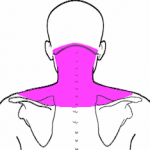During the course of attending massage school at A New Beginning School of Massage, students are given a number of assignments that requiring research and writing. Some of these assignments result in very insightful and well thought out information and decision-making outcomes. I am happy to share some of their assignments for you to enjoy.
On March 30th a friend and client, I'll call Aaron, came to me with stiffness and a limited range of motion in his neck due, he believed, to sleeping on it in an odd position. This was the first time in my practice as a massage therapist that I was presented with an acute condition and asked if I could help correct it. Aaron was not interested in receiving a full body massage; he just wanted help alleviating his symptoms. His work is physically demanding in a field related to construction, so not having full range of motion in his neck was proving difficult.
This was the first time in my practice as a massage therapist that I was presented with an acute condition and asked if I could help correct it. Aaron was not interested in receiving a full body massage; he just wanted help alleviating his symptoms. His work is physically demanding in a field related to construction, so not having full range of motion in his neck was proving difficult.
Aaron came to me two days after he woke with the symptoms. He was unable to rotate his head and neck to the left beyond a few degrees from center and could not fully extend his head. Aaron believed his symptoms came from a sleeping position but also indicated that he had been actively working since then, which likely exacerbated the condition; as he was snot allowing his body to rest.
Th stiffness Aaron was experiencing was the result, I believe, of muscles in his neck spasming as a result of overuse or incorrect use. In Aaron's case, it was likely a result of his sleeping position as well as his active job. The muscles involved appeared to be the sternocleidomastoid on the left side, and the splenius muscles on the left side. The superior and middle fibers of the trapezius, as well as the levator scapulae, appeared to be tense as well on both sides of the neck. With time and rest, this condition should have cleared itself up. Given the space to relax, I believe the range of motion in Aaron's neck would have been restored. If strain continued to be applied to the muscles, I imagine the condition could have worsened, causing headaches and radiating into other parts of the body.
For Aaron, I decided to perform a half an hour session focusing on positional release and stretching of the neck and shoulders. As the neck tightness was largely a result of an acute incident, I thought providing those muscles with relaxation through positional release and safe movement with light stretching was the best option. A shorter session providing pain relief and increasing range of motion was what my client wanted. Aaron was not interested in a full body session at the time, though I encouraged him to return for a relaxation session in the future to help with some of the chronic tension he held from having an active lifestyle.
In the June, 2014 issue of the International Journal of Physiotherapy, an article titled Effect of Positional Release Technique in Subjects with Subacute Trapzitis (Carvalho, Sweety Charles, et al.) showed that positional release combined with stretching had "significantly more added effect than trapezius stretching alone in improving pain, functional disability and cervical movement." In the study, a total of 8 sessions were performed over the period of 2 weeks; and both the control group and study group saw a decrease in pain and increase in range of motion. So, while stretching is effective in treating muscle spasms, it is not as effective as combining stretching with positional release therapy.
In treating Aaron, I hoped to decrease his pain and increase his range of motion; I believe the passive stretching and positional release techniques performed met these goals. While passively stretching his neck, Aaron indicated a number of times feeling the stretch continue into his arms and lower back. He did have reduced pain andgreaterr range of motion immediately following the session, and these metrics continued to improve over the following 48 hourse. Within two days of treatment, his range of motion had returned to normal and he experienced no pain. If Aaron returns for continued treatment, in addition to the passive stretching and positional release, I will perform Swedish relaxation techniques to encourage stress reduction and myofascial release because of the referred sensation he felt during passive stretching.
Reference: Sweety Charles Carvalho, Vinod Bau.K, Sai Kumar.N, Ayyappan V.R.. Effect of Positional Release Technique in Subjects with Subacute Trapezitis. Int. J. Physiolther: 2014;1(2).91-99.